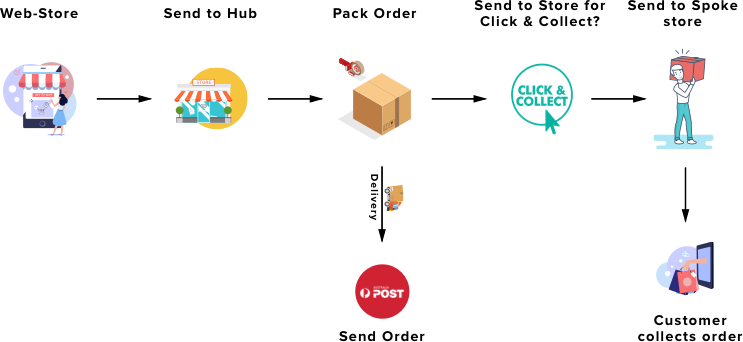Hub And Spoke Model
RANDEM - Do Better 20 November 2018
Welcome to our second edition of our RANDEM Bulletin. Most retailers are now entering the busiest period of their annual trading, however now is the time to start planning what projects you want to undertake for 2019. Some of our clients are asking about how to turn all their stores into a mini-warehouse, hearing about how some retailers have embarked on this recently.
However creating the optimum customer supply chain; that drives exceptional customer experience and reduces operational costs, will be challenging in implementing this model.
At RANDEM we don’t believe that’s the correct model for all retailers to follow, what we do believe you should consider is, the Warehouse to Hub and Hub to Spoke model, which we are currently implementing with one of clients to go-live Q1 2019.

The Warehouse to Hub and Hub to spoke model is much more efficient. The warehouse will send all its goods as normal for the retail outlets (all the Hubs and Spokes) however, the Hub-stores will retain the majority of the stock based on geographic locations to get the online store orders to the customer the next day. The Hub-stores will also have their spoke-stores within a close proximity, to be able to fulfil/ship an item to the customer via the spoke store located in metro areas within 2 to 3 hours for click and collect, or same day home/office delivery.
Building the business case with this model for our client saw a 30% cost reduction for fulfilment operations, as opposed to utilising the fulfilment from all stores model.
Some of the challenges we had to consider when we were deciding on the optimum store based fulfilment model, outside of the technology enablers were;
What is the role of the Sales Profession In-store?
The role of the sales person in the store is to engage and create the need to buy. That is a different competency of a warehouse process driven person. For example an order that comes into the store as well as customers who would walk into the store, guess who’ll be looked after first? You guessed it, the people will be served and the order will be unfulfilled. That’s correct as that’s the natural behaviour of the retail sales professional
How do we spilt the retail space and the sales and fulfilment roles?
Yes there are a benefits of utilising the retail floor space to fulfil from if, and a BIG IF, you have the space and the capability to split the floor space and the people within there. So you have your retail people on the sales floor and the people in your back-office doing the fulfilment from the store.
What will be the incremental operating costs at store level?
The obvious hidden cost of fulfilling from stores is incremental postage cost, because you could have 50 pickups across all store's for one item. A key consideration was also staff attrition costs, as potential to lose people because their skill does not match with what’s required from them.
Taking the warehouse to hub to spoke approach enables greater economies of scale to be achieved as well as giving you the ability to learn more around your supply chain and your stock and inventory management requirements at the store level, to ensure you get your click and collect right in store and your online delivery optimised in both cost and customer expectation.
At the end of the day, it’s all about your customer and their experience with the brand, this approach is enabling our client to create a customer driven supply chain and inventory management based business model, that is sustainable and able to adapt to the customer and market drivers.
If you have any questions in regards to this topic or would like to share some of your experience with us please do contact us at contact@randemgroup.com